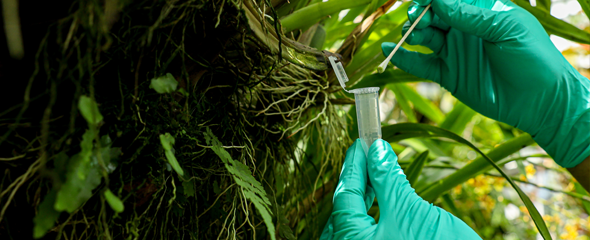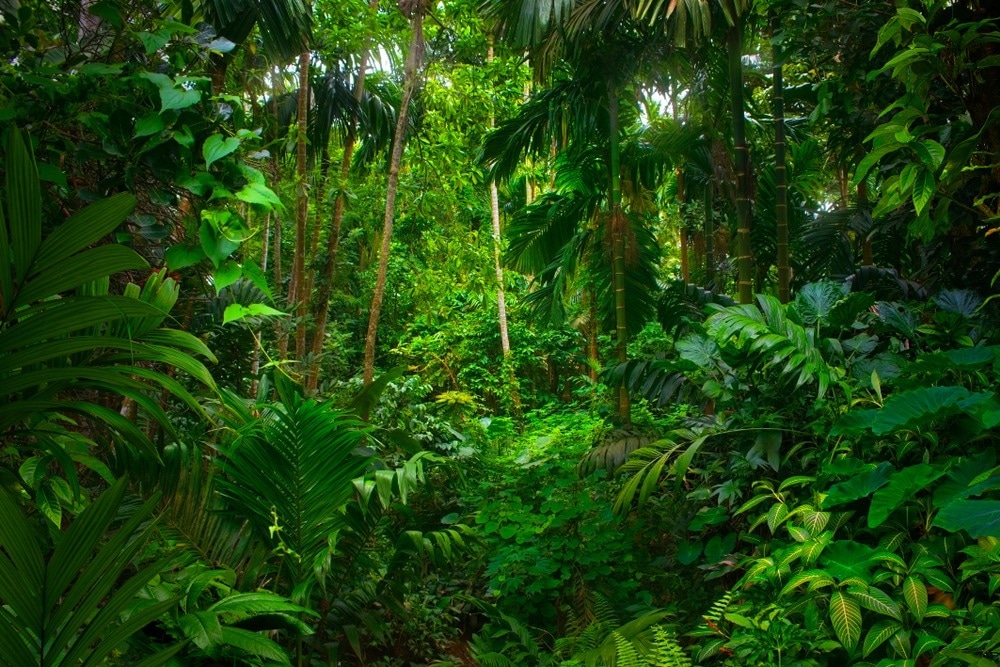Reviewed by Danielle Ellis, B.Sc.Aug 23 2023
An international research team demonstrates that the cotton buds themselves, which became familiar to all during the COVID-19 pandemic, are an important tool for mapping biodiversity. The Helmholtz Institute for One Health (HIOH) in Greifswald, Germany, a branch of the Helmholtz Centre for Infection Research (HZI) in Braunschweig, Germany, was the site of the international research team that carried out the research.
 Swabbing a leaf to collect vertebrate eDNA in the Greifswald Botanical Garden. Image Credit: ©HIOH/Andreas Sachse
Swabbing a leaf to collect vertebrate eDNA in the Greifswald Botanical Garden. Image Credit: ©HIOH/Andreas Sachse
The investigators showed that a large number of birds and mammals can be identified simply by swabbing the DNA left behind by animals on leaves. They demonstrated the effectiveness of this approach in a tropical rainforest ecosystem that is rich in wildlife but has historically proven difficult to detect. The findings were published in Current Biology.
Tracking changes in wildlife is important for informing adaptive management strategies and conserving biodiversity in the context of expediting rates of global biodiversity loss. Simultaneously, the majority of emerging infectious diseases originate in wild animal populations. Recognizing which animal species are present in which location is thus an essential step in estimating and possibly lowering the risk of infectious disease emergence in human populations.

Image Credit: Teo Tarras/Shutterstock.com
Molecular Ecologist Dr. Christina Lynggaard (Helmholtz Institute for One Health and Globe Institute at the University of Copenhagen, Denmark) and Community Ecologist Dr Jan Gogarten (Helmholtz Institute for One Health and Department of Applied Zoology and Nature Conservation at the University of Greifswald, Germany) guided the research. The research’s goal was to use simple methods to determine the species composition in a specific area.
Christina Lynggaard was a member of the team that recently revealed that animal DNA can be extracted from air, which inspired Jan Gogarten: “If animal DNA is in the air all around us, perhaps it settles and gets stuck to sticky surfaces like leaves. The rainforest and its plants are often called ‘the lungs of the planet’. Could the lungs of the planet represent the ideal place to sample settling DNA from air?”
The investigators set out to put this theory to the test in Kibale National Park in Uganda, a place known for its rich animal diversity that has drawn biologists for decades. The team entered the dense tropical forest equipped with 24 cotton buds and the strange task of swabbing leaves for three minutes with each of them, mainly cleaning as many leaves as possible within the timeframe.
Christina Lynggaard adds, “To be honest, we did not expect great results. The rainforest is hot and humid and these are conditions that cause DNA to quickly degrade.”
As a result, the investigators were astounded by the results of the DNA sequencer.
“We found DNA from an absolutely staggering diversity of animals in those 24 cotton buds - over 50 species of mammals and birds and a frog. And all from just a total of 72 minutes of swabbing leaves,” noted Jan Gogarten.
Each cotton bud contained an average of nearly eight animal species, according to the researchers. These species included a wide range of mammals and birds, from the massive and endangered African elephant to a small sunbird.
The hammer-headed fruit bat, which has a wing span of up to 1 m, was discovered, as were monkeys such as the elusive L’Hoest’s monkey and the endangered ashy red colobus, and also rodents like the forest giant squirrel.
The great blue turaco and the endangered grey parrot were among the many birds discovered.
This diversity of detected animals and the high animal detection rate per swab showcase that animal DNA can be readily sampled from leaves. The high detection rate and the ease of sampling can make swabbing a new tool with which to inform wildlife management strategies.”
Dr Jan Gogarten, Community Ecologist, Helmholtz Institute for One Health
Human activities pose serious threats to animals all over the world, with biodiversity loss being especially severe in tropical areas. This loss has far-reaching repercussions for the ecosystems’ crucial services and functions, such as pollination and seed dispersal.
Monitoring animal populations is thus important for understanding the scope of ecosystem changes and guiding the development of effective management strategies. Furthermore, knowing what animals are where is vital for assessing the risk of disease spread in areas where wildlife may come into contact with humans.
With numerous factors rapidly changing on our planet, understanding how they influence wild animal populations is a complex yet critical task, and we anticipate that DNA detected with leaf swabs can provide us valuable insights. We know that many animals live in these dense rainforests, but we rarely see them, and their changing distributions are really difficult to map. This remarkably straightforward sampling method gives us an efficient tool to make the unseeable seeable.”
Dr Jan Gogarten, Community Ecologist, Helmholtz Institute for One Health
Christina Lynggaard concludes, “Leaf swabbing itself does not require fancy and expensive equipment or lengthy training to carry out, and so it can easily be carried out by citizen science programs. During the COVID-19 pandemic, testing required automated extraction of nucleic acids from millions of swabs per day, and the analytical devices were spread to every corner of the planet. What if these instruments could be repurposed for using swabs to monitor animals on a massive scale?”
Source:
Journal reference:
Lynggaard, C., et al. (2023). Vertebrate environmental DNA from leaf swabs. Current Biology. doi.org/10.1016/j.cub.2023.06.031.